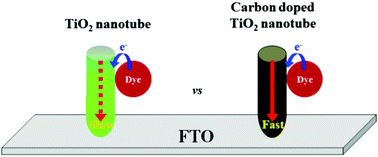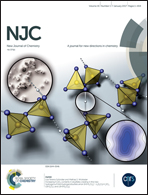Carbon-doped freestanding TiO2 nanotube arrays in dye-sensitized solar cells†
Abstract
Dye-sensitized solar cells (DSSCs) were fabricated with both closed- and open-ended freestanding TiO2 nanotube arrays that were doped with carbon via chemical vapor deposition to improve their electron transport properties. The energy conversion efficiencies of DSSCs increased from 5.07% to 6.21% after doping with a small amount of carbon, i.e., an enhancement of 22.4%. This suggests that the π–π conjugation introduced by carbon doping improved the efficiency of electron transport. However, energy conversion efficiencies of DSSCs with a large amount of carbon doping on the TiO2 nanotube arrays decreased from 5.07% to 2.87%, with a lower short-circuit current, open circuit voltage, and fill factor because of the reduced level of dye adsorption on the TiO2 nanotube arrays.


 Please wait while we load your content...
Please wait while we load your content...